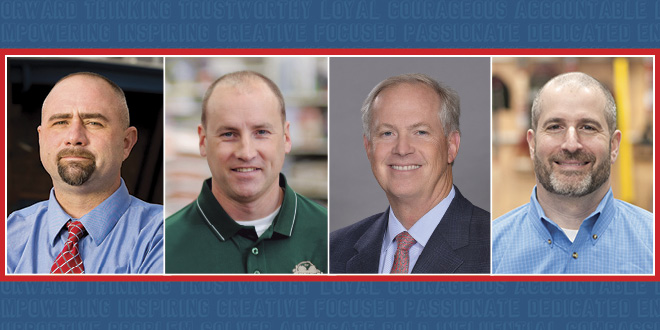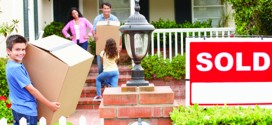To view a PDF of the story click here.
Best in Class
There’s no doubt about it—independent retailers in the home improvement industry are an innovative, thriving and progressive group. The industry is full of profit-focused, forward-thinking retailers committed to the growth and success of their businesses, local communities and the industry as a whole.
In an effort to showcase retailers who exemplify these characteristics, the North American Retail Hardware Association (NRHA), Hardware Retailing magazine and the National Hardware Show® created The Industry’s Top Guns award program.
The Top Guns award is the highest honor an independent retailer can receive from the industry, and has recognized nearly 40 leaders since 2007.
“We started the Top Guns program to recognize best-in-class independent retailers and change perceptions of the independent segment of the market,” says Dan Tratensek, publisher of Hardware Retailing. “We wanted to show that today’s leaders are progressive, dynamic entrepreneurs.”
Read below to learn more about this year’s honorees, their businesses and their industry perspectives. If you’re attending the National Hardware Show, see the honorees in a live panel discussion at the NRHA Village at 1 p.m. on Thursday, May 5. In this story you’ll find exclusive information that was not featured in the magazine.
The 2016 Top Guns include:
Eli Bliffert of Bliffert Lumber & Hardware
The Bliffert family has contributed business leaders to Milwaukee since the late 1800s. Still one of the area’s most successful familyowned businesses, Bliffert Lumber & Hardware continues to grow and thrive. Eli Bliffert became part owner in 2004, and his vision has helped the business grow to eight locations, streamline operations and find new ways to connect with the community.
Tim Fansler of Family Farm & Home
In 2002, three family members, Al Fansler, Bob Tarrant and Tim Fansler, started Family Farm & Home in Muskegon, Michigan. Backed with the Fanslers’ previous experience at Quality Farm and Fleet and Tarrant’s experience as an accountant, they opened three stores in 2002. The company has grown quickly in 14 years, and today operates nearly 50 locations.
Jack Foxworth of Foxworth-Galbraith
Foxworth-Galbraith has been a prominent Southwest retailer since 1901. The company operates 25 retail locations, as well as residential and commercial construction supply distribution and component manufacturing operations. It experienced significant difficulties during the Great Recession, when sales fell nearly 80 percent. The company successfully weathered the storm with the help of Jack Foxworth, coming back in just three years to $300 million in revenue.
Jeremy Melnick of Gordon’s Ace Hardware
What began as a small, family-run hardware store in urban Chicago in 1950 has become one of Chicago’s most successful multiple-location retailers. Since Jeremy Melnick left commercial lending and joined Gordon’s Ace Hardware, the business has grown from one location to eight. The business also supports Lurie Children’s Hospital of Chicago and is among the top five Ace Hardware chains in the nation for fundraising for Children’s Miracle Network Hospitals.
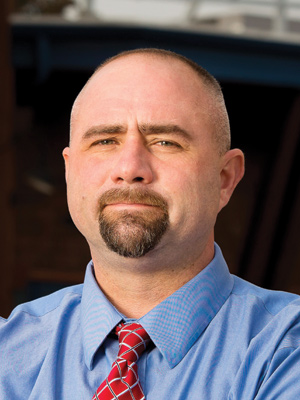 Eli Bliffert
Eli Bliffert
Representing Bliffert Lumber & Hardware
Eight locations in Wisconsin
Hardware Retailing (HR): Could you please give us a little background on your company, including how you got involved in the business?
Eli Bliffert (EB): Bliffert Lumber & Hardware started as a coal, ice and lumber company back in the late 1800s. We eventually grew to six locations. When my great-grandfather passed away, they got split apart, and each became a stand-alone lumberyard operated by a different family member. Fast forward to 1993. I graduated from college, moved to Milwaukee for grad school and needed a job. My mom said, “Call your Uncle Fred. He’ll give you a job.” I called my Uncle Fred in April and began working for him that summer. I only finished one semester of grad school before coming to the office full time in January of 1994 as the fifth generation involved in the business.
HR: When you became part-owner of Bliffert Lumber & Hardware, each of your locations was operated independently of the others. You were instrumental in bringing all of these entities together to create a cohesive operation. How has that decision strategically altered your business?
EB: It completely changed us. My side of the family owned two yards before we started the merge, and we’ve added two nonfamily locations since then, making eight total. I don’t believe any of them would still be in business if we were all independent. In our part of the world, there are very few independent single-location lumber companies left—you’re either a national chain or a multi-store operation.
We can leverage our strength and buy so much more with several locations than we ever could have separately, especially as Do it Best Corp. memberowners. When I started, we were a traditional line yard, and it’s amazing what a variety of different products we sell now. Last year, one of my guys sold a half truckload of charcoal. We never could have done that without the relationships we’ve developed through the depth and breadth of product mix we have now, thanks to our combined buying power.
HR: Bliffert Lumber & Hardware has a rich history as a family business. How do you prepare for the next generation of leaders to move along in the operation?
EB: Start them young. My kids both work part time here to get a feel for the business, and several of our other locations have the next generation participating, as well. One of our managers has all three of his sons working with him.
HR: What advice would you give to other family business owners looking to achieve the same kind of success throughout the generations that Bliffert Lumber & Hardware has seen?
EB: I’d say don’t give up. Too often I’ve seen small retailers just give up—sell the real estate and call it quits. A lot of people regret that; it’s better to merge with somebody else than to quit, and we’re stronger together than we are apart. In my experience, we have more to leverage together, while allowing each location to keep its local identity and its people doing what they’re good at.
HR: What unique challenges do you think independent retailers such as yourself face in today’s market? EB: The biggest challenge is what we call retail relevance. We struggle to be relevant, especially to a younger generation of potential customers. In the city of Milwaukee, there are 600,000 people, and we are the only lumber company left. There used to be several.
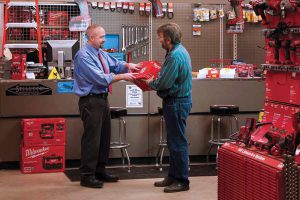
I look at it this way: if you are a 20-something homebuyer and your parents or grandparents never took you to a lumberyard, you might not even know they exist, much less what they have to offer. There are a lot of markets around the country where the only option is a big-box store, so customers don’t even think about a local store. Add to that the advertising budgets of these large retailers, and it really becomes a struggle to achieve relevance in the minds of that younger generation. We only had experience in lumberyards until our first retail hardware store opened in 2009, and we still have a lot to learn about the retail market. Do it Best Corp. is a great partner in helping us improve our layout and merchandising to appeal to this generation of shoppers. We will continue to collaborate with them on retail performance programs and aggressive marketing strategies to grow our relevance with this audience.
HR: What are some of the biggest misconceptions about today’s independent home improvement retailers?
EB: I think it’s still price. Customers think we can’t compete and it’s completely not true— we are priced competitively on most items—but that’s the perception.
HR: If you could wave a magic wand and change one thing about this industry, what would you change? EB: I don’t think I’d change anything; it’s a great industry to be in. You can still do so much with a handshake, and it helps so many people. I suppose if I could, I’d slow the tide of independents closing. We’ve had three close in the last six months in this area, and friends of mine owned some of the lumberyards that shut down. That’s a hard reality.
HR: How would you respond to the statement “Independent retailers just can’t compete against the big boxes or the Internet?”
EB: There are times when we can’t compete; there are certain segments where we will be a niche or a fill-in, and that’s OK. The key is to focus on areas where you can compete, where you can offer knowledge and experience to benefit customers in a way e-tailers and big boxes cannot.
HR: Please finish the following statement. Ten years ago, I never thought our business would…
EB: Be eight locations strong and growing. I never thought I’d be serving on the board of directors for Do it Best Corp. And I never would have thought so many of my friends and fellow business owners would be gone from the industry.
BONUS COVERAGE
HR: What do you feel have been the keys to your operation’s ability to grow and thrive over the years.
EB: First, it’s the people. We have some outstanding long-term team members, and we just couldn’t do what we do without their knowledge and experience.
Continuous family ownership has been another advantage. Our steady tenure has allowed us to focus on long-term goals and relationships, both with staff and customers.
Our partnership with Do it Best Corp. has been invaluable to us as well. We did not have a co-op affiliation until around 2009, and we made a great choice. Do it Best Corp. offers hardware as well as lumber and building materials, and is truly proficient in both areas. Plus, their finance and advertising departments have played a key role in helping us bring these separate business entities under one roof.
HR: What would you say are the greatest assets independent home improvement retailers have at their disposal?
EB: Our staff’s depth of knowledge and long-term stability are important ones. We’ve had a presence in this community for so long that we’re able to identify products that are central to our community, but that a big-box retailer wouldn’t know about. Another asset is our ability to be flexible—to do what we want to do. From charity or health causes, to customer-focused offerings that fall outside normal business practices, such as controlling our own accounts receivable credit limits, our flexibility lets us better meet the needs of our customers, staff and community.
HR: Where do you see your business in five years?
EB: I think we’ll have one or two more locations within five years. We want to work on an advertising campaign to fuel continued growth by capturing more of the retail market. We have a larger share of the commercial builder market, but there’s opportunity on the retail side.
HR: Where do you see the home improvement industry in five years?
EB: We believe that as the older generation goes away, this newer generation of customers will have much less “how-to” knowledge. That will change the industry somewhat, with fewer DIYers creating a need for more handymen. Those who want to become DIYers will need more help and instruction, so we’ll be spending more time directly with customers, showing them things they have not been taught—even basics like how to light a water heater.
HR: What is your favorite part of your job and what is the most challenging part of your job?
EB: The people are both my favorite and the most challenging part of my job—both customers and employees. To give some perspective, 12 years ago, we had two locations with 20 total employees. We now have eight locations and 155 full- and part-time employees, and we’ve more than quintupled our sales. Recruiting can be a challenge, as this isn’t an industry young people think about entering, but we haven’t experienced a lot of turnover. I think that’s because we treat our employees well, with good health insurance, 401(k)s and profit sharing.
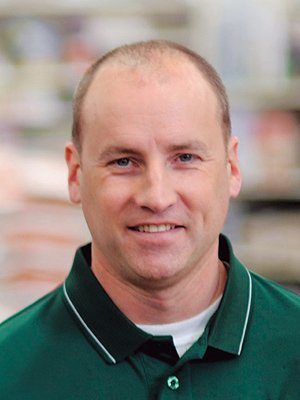 Tim Fansler
Tim Fansler
Representing Family Farm & Home
46 locations in Indiana, Michigan and Ohio
Hardware Retailing (HR): Could you please give us a little background on your company, including how you got involved in the business?
Tim Fansler (TF): My father, Al Fansler, brother in-law, Bob Tarrant, and I started the company in 2002 with three stores. Al Fansler serves as our chairman and CEO, Bob is our co-president and chief operations officer and I work as co-president and chief merchandising officer. Our past experience helped us to get the company started. Al Fansler had many years in operations, Bob is an accountant and I had previous experience in buying and replenishment.
My father and I both worked at Quality Farm and Fleet, so we already had experience in the farm store industry. When Quality Farm and Fleet filed for Chapter 11 and closed more than 100 stores, it left a pretty big void in the market, especially in Michigan. That’s when we made the decision to go into business for ourselves and restart that type of store. We knew the format worked, and we seized the opportunity.
Since opening, we have grown rapidly as our brand has gained traction. We’ve been able to gain momentum and continue to grow at this pace for quite a while now. This year alone, we had four grand openings in April and just announced three more locations for the second half of 2016, which will put us at a total of 50 stores by year-end.
HR: What do you feel have been the keys to your operation’s ability to grow and thrive so quickly over the years?
TF: To grow new stores, your comp-store (sales) have to be growing. We have had comp-store growth throughout the years, which has been the engine that fuels our overall growth. You cannot have growth unless you have the capital to invest back into the company.
One of the specific things we’ve done over the last year is focus on our loyalty program. We really feel it will be a key driver to future growth and sales.
The customer relationships gained with the loyalty program, whether it’s direct email interaction or targeting and segmenting customers by what they’re shopping for and driving them back in with coupons or upcoming specials on items they’ve previously purchased, are really important to us.
We tested it exclusively for about three years, working very closely with True Value to develop it, and just rolled it out company-wide last April. It’s been very successful, and we’re very proud of what the stores have done to explain the program to customers. Signups have been tremendous, and we’re excited about where that’s headed in the future.
HR: As you grow, how do you ensure you’re staying connected with the local consumers in each community?
TF: That’s one of the things we allow the store managers at the local level to drive. The store manager is the face of the store, so we allow them to do things on a local level that can keep us in touch with local supporters who are going to come in to our stores.
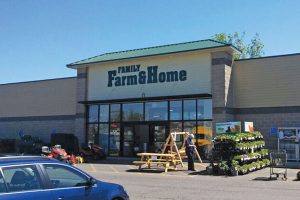
The manager communicates with our marketing team in Muskegon to support them in their endeavors, whether it’s through posting on social media, attending local fairs or having 4-H groups come in to sell hot dogs that we supply them with and let them serve to raise funds for their local group.
HR: What are some of the biggest misconceptions about today’s independent farm and home retailers?
TF: We at Family Farm & Home have always had the mentality that we weren’t going to be perceived as less sophisticated. We’ve never thought of ourselves as not being able to compete or provide value to our customers just because we’re an independent, family-owned business. So, it’s about a level of confidence. Independents have a higher level of confidence, keen attention to detail and work ethic that’s going to continue to push them and their businesses forward. We’ve got that same mentality here.
HR: How would you respond to the statement “Independent retailers just can’t compete against the big boxes or Internet?”
TF: You really don’t have a choice, because you’re already directly competing with them every day. You’ve got to make a decision about who you are and what you want to be, and make sure you’re conveying that in everything you do.
For us, we’ve chosen to be a farm store first. We have other products, but it’s that unique mix of products that keeps us relevant. You can find everything in our store someplace else, but you really can’t find it all in one place unless you shop us.
We’ve also got good prices every day and knowledgeable team members that service the customer well—it isn’t just one thing you can focus on. You’ve got to do everything really, really well to compete with the big boxes and, for us, to compete with other national and regional farm stores.
HR: Where do you see your business in five years?
TF: We are a growth company and plan to keep going.
We’re going to continue to grow at our current pace, which is comfortable for us, and a lot of it will be dependent upon the results we have at year-end.
When it comes to store count, how many locations we want to have, everybody asks me, “What’s your total store count goal?” We have no idea. The three of us have never sat down together and set a goal number or put a cap on it. However, if we do continue to grow at the pace we’re growing at now, we’ll be at 100 stores in another five years.
In short, we’re going to continue to move forward and expand at a rate that’s best for our company.
BONUS COVERAGE
HR: What sets your business apart from the competition?
TF: We try to provide a unique mix of products, as well as services that fit those products. We pride ourselves on having products in stock and on providing service at the store level. We also make sure to provide training for employees at the store level so they can deliver the level of service customers expect and want today. Customers want quick, easy, in-and-out opportunities, and they want you to be in stock. Being in stock is a huge aspect of customer service. That trust you can build with the consumer if you consistently have the things they need in stock is key. Providing good service today means being able to meet all of those needs for the customer at once.
HR: Your organization has rapidly grown since you were established in 2002. Has the rapid growth plan always been a part of your business model?
TF: It was born out of the success we had with our first three or four stores. Once we gained some market acceptance and customers began to understand who and what we were and what we could provide—especially our high level of customer service—then the sales took off. We’ve been able to gain momentum ever since and grow at a steady pace.
In the beginning, this kind of growth probably wasn’t part of the initial plan. In at least the last five years, the pace of growth has picked up and remained steady. The goal is to continue to grow at the pace we’re growing at now. It’s a comfortable pace. The buildings are available for us, and we’re already negotiating leases as far out as 2017, at this point.
HR: Can you speak to how your team members have been instrumental in your growth?
TF: We’re a buying and selling organization—that’s the goal. We’ve got a group of buyers here in Muskegon that have done a great job of sourcing products, whether it’s through True Value or some of our direct relationships. Then, we have a team of five district managers that are out in the stores, directing the stores and implementing the vision that Al Fansler, Bob Tarrant and I have for those stores—how we want them to feel and what we want to present to the customer on a daily basis.
HR: What would you say are the greatest assets independent farm and home retailers have at their disposal?
TF: For us, we are operating as a farm store first, with hardware and other home essentials in stock, allowing our mix of products to be our greatest asset. I would also say our affiliation with True Value is a great asset for us. They have taken the majority of the distribution issues away from us, allowing us to focus on growing our business and establishing new stores.
HR: What unique challenges do you think independent retailers such as yourself face in today’s market?
TF: When we’re in growth mode, introducing stores and the Family Farm & Home brand in new markets can be a challenge.
We work to ensure that we’re staying relevant with product selection, customer service and clean, inviting stores to set us apart. Those are all key elements of our brand and we work to build upon them in each community we’re a part of everyday.
We try and stay connected with our markets and advertise that we’re a part of each local community. Our loyalty program is key and we utilize email marketing to connect with those customers, but our go to, everyday program is our circular program. We do biweekly circulars that are inserted in the local communities’ newspapers. We insert roughly 30 a year, hitting the key months of April, May and December with a few extra pieces. That’s our primary method of advertising and communicating with customers. For our markets, it’s absolutely proven to be the most effective way for us to connect. In some of the metro markets it might become a little more difficult to zone by zip code. However, when you’re in a more rural market where consumers already know who you are and the newspaper is still relevant to them we make sure we’re utilizing circulars to the best of our ability.
HR: What would you say is your favorite part of your job?
TF: Because we’re a family business, I get to be a part of building something that’s not just for me; it’s for my family, my team members and all of the employees. It’s a great environment. We’ve done a good job of growing quickly while still maintaining a family atmosphere. I think our team members enjoy coming to work every day and it’s nice to see them productive and enjoying what they’re doing. It’s hard work, but it’s fun.
HR: What would you say is the most challenging part of your job?
TF: It’s been managing the growth and the expansion of the team to make sure we’re maintaining the same atmosphere and company standards. While it’s a joy and a pleasure to have a family atmosphere, it also becomes more and more difficult every day to keep that culture. It’s important to the three of us [myself and the other owners, Al and Bob] that we maintain that culture, and that gets more and more difficult as we become larger and larger.
 Jack Foxworth
Jack Foxworth
Representing Foxworth-Galbraith
25 locations in Arizona, Colorado, New Mexico and Texas
Hardware Retailing (HR): Could you please give us a little background on your company, including how you got involved in the business?
Jack Foxworth (JF): We’re a 115-year-old business that two families, the Foxworths and the Galbraiths, have owned since 1901. I am one of the fourth-generation family members involved in the business.
We’re largely pro-focused—about 85 percent of our revenue comes from that customer base, which is largely residential construction and some light commercial business, but also includes repair and remodeling customers. The balance of our business is consumer and DIY via our 25 retail locations.
Our company also does some light manufacturing, building construction components such as floor trusses, roof trusses, wall panels and doors in select markets.
We grew to about $830 million in revenue in 2005, which was a big run-up for us in the early 2000s when construction was still thriving in the United States. We were up to 75 locations and 2,800 associates. Then when the financial crisis hit in 2008, we had a five-year window where our company contracted, most of it intentionally, from $830 million to $145 million. We went from 75 locations down to 23 and 500 associates. But the good thing is we’re back, thriving again, growing and feeling very positive about where we are today.
As for me, I was a nerd—and I consider the term a compliment. I worked for Intel from 1980 to 1982 and joined Foxworth-Galbraith in late 1982. I had a good gig going at Intel, but I got a little impatient and wanted to be a bigger fish in a smaller pond. Because of my computer background, I started out in emerging POS systems. I really found my first opportunity to grow when the company was hit by the recession in the late 1980s. That’s when we experienced some personnel changes and had some voids in the company, so I took the opportunity to fill them in terms of finance and our banking relationships.
HR: What do you feel have been the keys to your operation’s ability to adapt and maintain your position as a leading lumber and building materials company during changing economic climates and the Great Recession?
JF: It was very painful. In my opinion, what got us through was the company culture. It was about living up to our reputation in the industry and the commitments we made—whether to our customers, who were also struggling at the time, our shareholders or our vendors. Conservative financing and an incredibly strong balance sheet really helped us weather the tough times. We had little debt and owned all of our own facilities, and people were committed to the survival and success of the company. Where other families may have been very demanding of the business, our shareholders really understood the situation.
Throughout the experience, we were very transparent with everyone, and our communication was very proactive. Our mission statement today strongly emphasizes customer loyalty. Even back in the toughest times of 2008-2012, those pro customers that survived the recession were very loyal to us, as was our retail customer base.
HR: What unique challenges do you think independent retailers such as yourself face in today’s market? JF: I think there is always a perception that big boxes have the lowest prices. The boxes can set a perception in many markets with some really low-priced offerings, but overall, most of us independents can compete with the boxes on price.
Something else that has emerged recently is recruiting young people in an industry that I think a lot of people consider to be an older industry. I think this industry is challenged by labor forces today and will continue to be in the future.
HR: How can the industry work to combat this misconception and attract the next generation of store employees and leaders?
JF: I recently heard a speaker at a roundtable meeting who discussed generational differences. Really starting to listen and understand what drives millennials, and to some extent Gen Xers, puts us in a better position to understand them and create

a culture in which they want to participate. It’s not about money; that’s not the driving force. There are other things that we as independent retailers can bring to work environments to be more appealing, but that’s a big change for us as an industry. It’s going to take some time, culturally, for us to adapt and to get the older generation that thinks one way and the newer generation that thinks another way to mesh. I think we have the opportunity to make it work, but it won’t be easy.
HR: Where do you see your business in five years?
JF: We’re feeling very positive about the future. We want to focus on who we are and not dilute ourselves. But like any other surviving and thriving organization, we’ll be larger. We are in acquisition mode. We’ve been speaking to a variety of organizations over the last couple of years and are hopeful we are going to grow through some acquisitions. I also see us growing organically as our customer base grows with new construction and new housing starts in our current markets. I’m sure we’ll also be adapting to new products and construction techniques, and we’ll also have some evolution with technology. I think we’ll be in the same geographical areas. We might stretch it a little bit, but we’ll stay focused in the Southwestern United States.
HR: If you could wave a magic wand and change one thing about this industry, what would you change.
JF: I’m torn between two things. First, if I could, I would create some stability in commodity pricing and the availability of commodities, creating some consistency over a longer period of time. I would love to create some predictability there, which would do a world of good for our customers and for us.
Second, I would also love to create a stable labor pool for our industry. I’d love to wave a wand and get younger people to see, understand and embrace the opportunities within our industry. I’m pretty sure even a magic wand won’t help with commodity pricing and supply availability, but it might be a little more value in terms of educating and helping us as an industry evolve to accommodate millennials. I think there is more hope in that area.
HR: Please finish the following statement. Ten years ago, I never thought our business would…
JF: Go to hell and back, and now growing profitably.
BONUS COVERAGE
HR: Your business is unique in that you are also serving a large commercial building customer base in addition to homebuilders and DIYers. How is the commercial building experience different than serving traditional homebuilders?
JF: We do have what I call a light commercial business. We’re not selling into urban Dallas and high-rise projects, but we do sell into projects such as strip shopping centers, restaurants and schools. It’s not a huge part of our business, probably about 10 to 15 percent of our revenue.
One big difference in these commercial jobs is the job cycle and timing. There can be a long period of design, renegotiating of bids and the like.
We’re usually selling commodities into these jobs, so our ability to price forward for an extended period of time and take some of the risk out of the equation for our customers in a volatile commodity market is one of the main differences. When we’re selling commercial jobs we are usually cherry-picking certain products at a larger volume. This allows us to frequently send these commodities via direct shipments. We might be delivering multiple truckloads of product around the country at one time.
When the commercial jobs are within our four-state footprint, we also have the ability to utilize and leverage our 25 branches, enabling us to pick various locations from which we can sell the product, as well.
HR: What do you think sets your retail operation apart for the competition?
JF: The communities we have stores in tend to be smaller, secondary communities outside of the urban population. They tend to be a little more traditional and want the warm, personal experience we can provide.
Because we still have a large professional customer base in those communities, we can take the experience and expertise we apply to the pro side of the business and make it available to the retail side. When customers come in, we can provide some expertise they may not find readily available in the boxes, and that some of our competing independents might not have either.
Our management team has also become pretty involved in the communities. They serve with various volunteer and civil service organizations, and get really embedded in the communities. I think that makes a big difference.
Because we are focused on the local customer, we can sometimes move quicker than some of our competitors. We can be a little more nimble. We can quickly change product sets. If there is a need for new product in a market, we can get it in faster. That is helpful. The predictability and certainty of who Foxworth-Galbraith is, is important to folks.
HR: How would you respond to the statement “Independent retailers just can’t compete against the big boxes or Internet?”
JF: I would disagree. Anyone who says and believes that probably hasn’t researched and doesn’t understand how independents can compete. I think if you ask most Top Guns and many of the independents that have survived, they will disagree right out of the chute.
That doesn’t mean its not going to be difficult, but that’s how, as an industry, we all get better. You could rephrase the question to “Where is it going to be tough?” or “How is it going to be tough?” For Foxworth-Galbraith, we’re going to have to look at how we are investing in the shopping experience, and how we’re using technology—and in particular, the Internet.
I know some fellow independent retailers are trying some forward-thinking online ideas, which is exciting. It may be a little premature in our organization because of the types of markets we’re in, but I think even at Foxworth-Galbraith, we’re going to need to have an easier Internet-based shopping experience in the future.
We will certainly use the Internet relative to our professional customers, and invest there today. We’re going to have to look at more ways to make the shopping experience easier for our consumer customers. In our markets, we still have a lot of customers who want to walk in the store and have a warm experience and a relationship with staff. So, we still have those environments that the Internet and boxes can’t impact.
HR: What is your favorite part of your job?
JF: Seeing and being part of a company that is growing again. Whether it’s through mergers or acquisitions, new markets or new customers, seeing the company grow again profitably is really one of the most fun things going on.
Even more than that is seeing light bulbs go off in the minds of our associates when they realize the value and importance of a great customer experience, and how they can influence it. It’s great to see our customers happy, but it also validates our company’s mission and desire to build loyalty with our customers.
HR: What is the most challenging part of your job?
JF: I think the tough thing right now is to make sure we are shifting away from the “hunker down” mindset we had 2008 to 2012, during the Great Recession. During that time, we were very focused on cash flow, liquidity and receiving immediate returns, and we had to sacrifice longer-term investments and strategic initiatives.
We’ve come out of that five-year window kind of bruised. I don’t think we’re licking our wounds anymore, but there’s a pretty good memory of those times. We still need to be aware and focused on profitability but shift it to a longer-term view. When you have those memories, you’re probably not as objective in weighing that scale, but we’re getting better and taking a little more risk as we continue to reinforce the company’s performance.
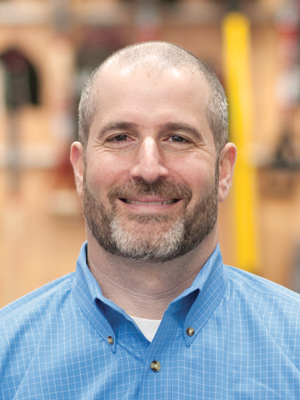 Jeremy Melnick
Jeremy Melnick
Representing Gordon’s Ace Hardware
Eight locations in the Greater Chicago Area
Hardware Retailing (HR): Could you please give us a little background on your company, including how you got involved in the business?
Jeremy Melnick (JM): The Gordon’s Hardware family business has been around since 1950, when my grandfather, Art Gordon, opened a small 2,000-square-foot hardware store in downtown Chicago. My father, Les Melnick, took over the business in 1970. He did a tremendous job of growing the business into one that allowed me to join the team in 1998. Together, my dad and I have grown Gordon’s into an eight-store chain, culminating with our most recent expansion of three new stores, two of which were our first-ever foray into the suburbs. Our newest store is located back in the heart of Chicago. I can truly say I’m incredibly proud to be a third-generation hardware retailer.
HR: You spent some time in the commercial lending business before coming back to run Gordon’s Ace Hardware with your father. What unique perspectives do you think your time in that industry provided you that you were able to bring to your retail business?
JM: My time in the financial industry, particularly with Bank of America, taught me two extremely critical points that carry through to our retail business operations.
The first is financial acumen. Throughout my corporate career, I was exposed to a myriad of different financial models from a variety of industries, including retail. As a result, I knew what it would take to grow a business from small to large, and I tried to model our blueprint for growth off of what worked best for other companies.
Secondly, work ethic. Anyone who operates in this industry knows that, as entrepreneurs and small business owners, we don’t ever get to take a day off. Being in commercial lending and investment banking laid the groundwork for the rigorous schedule that comes along with a lifestyle of entrepreneurship. In the banking world, I would work an entire day, leave and go to my MBA courses in the evening, then go back to work late at night before starting all over again the next day. It taught me to push ahead and multitask, and the value of true work ethic.
HR: You recognized early on in your career that growing the number of store locations was essential to the success of your business, quickly moving from one to two locations, and then adding four more a few years later. What advice would you give another home improvement retailer looking to expand?
JM: Quite honestly, I would tell you to look bigger. Going from one to two stores is nice, but I would challenge anyone looking to grow to set goals based on a specific dollar volume and unit number of stores. One of the biggest risks in retail is to have all of your eggs in one basket. You need to diversify your investment—and having multiple stores can help you mitigate your risk.
In my opinion, running multiple stores is actually easier than running a single store. I have my teams in place, which for the most part can run the day-today operations, so that I can focus on the strategic business plan.
HR: What unique challenges do you think independent retailers such as yourself face in today’s market?
JM: As independent retailers, we face challenges every day, in nearly every facet of our business. I’ll be the first to tell you my business is not perfect. We know we have work to do, and I’d say we’re about halfway there. There’s always room for improvement.
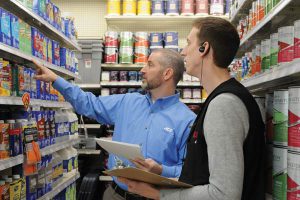
As it relates to specific challenges, we’re always going to be faced with bigger, better, more well-funded competition—whether that’s the big box down the street or the online giants that are capturing more transactions than ever before. But, we also can’t try to be something we’re not.
Probably the biggest challenge of all is one that we put on ourselves—the feeling that we have to wear every hat within our organization, all the time. It’s that constant juggling and prioritization of day-to-day operations, including human resources, financial operations, inventory and training—the list could go on and on. We have to challenge ourselves to take a step back so that, as leaders, we can focus on long-term growth.
HR: Where do you see your business in five years?
JM: We are going to be different than we are today, for sure. We will be larger. We will be more efficient than ever before. That’s part of the spirit of small business—you have to change and evolve or you run the risk of becoming insignificant to the competition. My hope is that in five years, if an opportunity presents itself, my company may be able to serve as a succession path for my industry peers who are ready to retire.
HR: Where do you see the home improvement industry in five years?
JM: I’ve been extremely fortunate to have the opportunity to visit with many independent retailers across the country. What I’ve seen in so many stores over the last decade is retailers embracing technology. We have only just scratched the surface on what technology can do for our businesses—it will keep us nimble and better able to compete and enable us to move faster. With more and better technology acceptance, the hardware store will be more than the mom and pop corner store—we’ll be more sophisticated than ever.
HR: If you could wave a magic wand and change one thing about this industry, what would you change?
JM: I want consumers and local businesses to think of the hardware store first. I don’t want to be their second or third stop in the purchase process. Before they click “buy now” on something online that they’re not 100 percent confident in, or before they drive 10 or 20 miles to the nearest big box, I want them to start with us, the neighborhood family-owned store, and let them see just how much we have to offer.
BONUS COVERAGE
HR: What do you feel have been the keys to your operation’s ability to grow and thrive over the years?
JM: Truly, the people are the most important element of our business. The personnel within our organization have and will always be the backbone of the operation’s success. As owners, we can’t do everything on our own; we have to be willing to let go of some of the control—and that’s where having an outstanding team that you trust comes in to play.
In addition, having a solid infrastructure to grow your business on is essential. When we acquired the four-store chain in 2007, we also inherited its infrastructure, including the back office systems. To be able to merge our passion and dedication for the business with these operational efficiencies was a big win for everyone involved.
HR: What are some of the biggest misconceptions about today’s independent home improvement retailers?
JM: In my opinion, the absolute biggest misconception is the idea that, because we’re smaller than the big boxes, we can’t compete. People don’t know we have timely access to thousands of products that aren’t within the four walls of our stores.
The reality is, customer service and that special, personal touch of helpfulness will always rule. But we can’t be satisfied. What is considered great today may be considered average tomorrow.
What I love most about being part of Ace Hardware is that you have the best of both worlds. You have the scale and access to products that a bigger company would have, backed by a Fortune 500-equivalent brand. And in the same breath, when you’re in the store, you can feel the community, the sense of neighborhood—and in many cases, you’re standing only a few feet away from the actual owner of that store.
HR: What would you say are the greatest assets independent home improvement retailers have at their disposal?
JM: For us, partnering with Ace Hardware means we’re independent, but we’re not alone. We’re backed by the infrastructure and scale of a world-class business. They are an absolutely outstanding resource for our stores.
The other greatest asset we all have as small retailers is the ability to adjust on a dime. No other business can react and change its product mix and promotions as quickly as we can. As an example, here in Chicago, when an early or late-season storm is forecast, I can be the only store in stock for miles because the big boxes simply can’t compete—they’re not as agile as we are.
HR: How would you respond to the statement “Independent retailers just can’t compete against the big boxes or Internet?”
JM: It’s clearly not true. As long as we pick and choose our battles and play to our strengths, we’re going to be fine. Any independent retailer who has been around for a long time knows the key to success is finding your niche: Find what you’re good at and don’t stop.
HR: What is your favorite part of your job?
JM: The ability to be an entrepreneur is the absolute best part of my job. The fact that I have total control over my business and I can explore all opportunities is something that makes me thrive.
In addition, I am extremely fortunate to be able to use my business to improve the lives of others. The ability to raise funds for my local Children’s Miracle Network (CMN) Hospital has been unbelievably rewarding for my family, my entire staff and me. I’m proud to say I’ve grown our chain’s fundraising record to be among the top five chains in the nation for all of Ace Hardware. Supporting our local CMN Hospital, Lurie Children’s Hospital of Chicago, has been a motivating factor for my crew, because they know they are working for something bigger than just a paycheck.
HR: What is the most challenging part of your job?
JM: Probably the biggest challenge I face is one of balancing the role of being boss, mentor, colleague and, in many cases, friend, with my associates. I absolutely love the people, and when you run a business, you walk a fine line that sometimes can become blurred when it comes to the people that work for you. Sometimes, doing what’s right for someone that works for you trumps what’s best for the bottom line. It’s about having heart.
HR: Please finish the following statement. Ten years ago I never thought our business would…
JM: … have stores in the suburbs! I truly never thought I’d be selling lawn mowers and buying trailers full of dirt—it’s so different from the urban model our company has operated exclusively for so many years. Again, it goes back to the diversification of my business model. Now I can watch the ebbs and flows of the business from the urban vs. suburban formats, learn from the peaks and valleys and continue to grow.
 Hardware Retailing The Industry's Source for Insights and Information
Hardware Retailing The Industry's Source for Insights and Information



